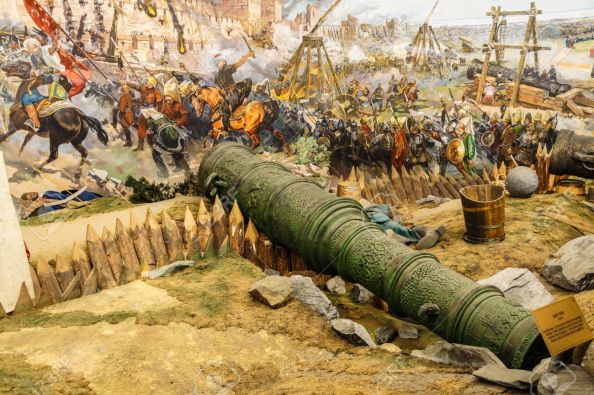Turkish Bombard 1:10 scale
by John
Just for fun I will use my newly converted CNC lathe to make a 1:10 bombard. The original was cast in 1464 and was thought to be a close copy of the bombards which Mehmet 2 (“the conqueror”) used to breach the walls of Constantinople in 1453. There are several of these bombards still in existence, including one in UK, which was given to Queen Victoria by the then Turkish Sultan.
These bombards were last used, against the British, in 1807, when a British warship was holed with substantial loss of life. Pretty amazing for a 340 year old weapon.

5.2 meters long, 1.060 meter diameter. 16.8 tonnes.

The large thread connected the halves. Easier transportation, and casting.

Is this Turkish or Arabic?

Granite balls are 630mm diameter.

A reconstruction of the walls of Constantinople, with moat. Almost 1000 years old in 1453

And as they are today. Massive. High.

Huge siege cannon used in the final assault and fall of Constantinople in 1453. Diorama in Askeri Museum, Istanbul, Turkey. The bombards were probably dug in, to manage the massive recoil, and concentrate the aim at a particular wall section. There is a wooden structure built around the cannon in the background of this modern picture. As far as I know there are no surviving wooden structures like this. Nor have I come across any old pictures, but if anyone knows of any I would be very interested. The bombards took about 3 hours to cool, cleanout and reload.

My model will be about 520mm long. I would like to make it from bronze, or gunmetal as in the original. Any mistakes will be costly.
So I have decided to make a prototype in wood. That will test my drawing, the machining procedure, and the final appearance. Not to mention how the CNC lathe will handle the task.
I will use a very dense, tight grained Australian hardwood (red gum). The wood was salvaged when my house stumps were replaced with concrete. Some was used to make parquetry, and the rest was put aside for possible future use. Such as this.

About to cut off the below ground section of a 70 year old house stump.

A 5hp metal lathe with a tungsten bit chomps through the hard dry wood.

I turned 6 lengths before I found 2 that were satisfactory. The rest had sap holes or splits.
I have used Ezilathe to generate the G codes.
to be continued….

Maybe you can turn the red gum model into a potato cannon…
LikeLike
Ha ha. I like it!
LikeLike
Can’t wait to see your results!
LikeLiked by 1 person
I think this gun iş breech leader. The carriage design iş unknown.io
LikeLike